Method for exploring disease-related SNP combination based on evolutionary algorithm in genome-wide association analysis data
A genome-wide and association analysis technology, applied in the field of evolutionary algorithms, it can solve the problems of GWAS data analysis, reduce the search space, and have high memory requirements, so as to improve accuracy and interpretability, reduce time and space, and reduce memory. effect of demand
- Summary
- Abstract
- Description
- Claims
- Application Information
AI Technical Summary
Problems solved by technology
Method used
Image
Examples
Embodiment
[0144] Such as Figure 4 As shown, the CD (Crohn's Disease) data set in the WTCCC1 seven disease data sets is analyzed by the SEE algorithm in the present invention, and the second-order SNP combination related to CD is explored, and finally the SNP in the result is converted into a gene marker according to NCBI , to get a series of gene pairs, this figure is a network drawn based on these gene pairs, where each edge represents that there are at least 4 SNP combinations and CD are related to the two connected genes, by Figure 4 It can be clearly seen that the SEE algorithm determines that genes such as LDB2, LOC107986262, RRP15, and SMG1P5 may play some key roles in CD, which is worthy of further study.
[0145] The technical solution of the present invention aims at the problem of insufficient precision of the current algorithm, and proposes to fuse 8 different indicators for evaluating the relationship between SNP combinations and diseases by using a sorting method, wherein...
PUM
 Login to View More
Login to View More Abstract
Description
Claims
Application Information
 Login to View More
Login to View More - R&D
- Intellectual Property
- Life Sciences
- Materials
- Tech Scout
- Unparalleled Data Quality
- Higher Quality Content
- 60% Fewer Hallucinations
Browse by: Latest US Patents, China's latest patents, Technical Efficacy Thesaurus, Application Domain, Technology Topic, Popular Technical Reports.
© 2025 PatSnap. All rights reserved.Legal|Privacy policy|Modern Slavery Act Transparency Statement|Sitemap|About US| Contact US: help@patsnap.com



